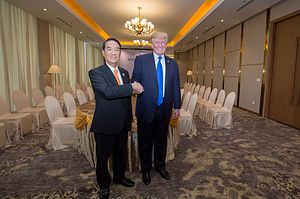U.S. President Donald Trump recently completed his first Asia-Pacific tour, offering a glimpse into the administration’s strategic direction on U.S.-China relations and its role in the Asia-Pacific. While not explicitly addressed during the trip, Taiwan’s role comes into play between these two competing superpowers in the Asia-Pacific region.
In China, as in preceding stops in Japan and South Korea, Trump sought to address critical issues regarding trade, North Korea, and regional security. Beijing, for its part, hoped that Trump’s visit would bookend, and complement, the 19th National Congress of the Chinese Communist Party (CCP). By visiting Beijing shortly after the 19th CCP Congress, Trump provided symbolic support for China’s reform efforts and Xi’s new administration.
Trump’s visit to China was just one milestone, albeit an important one, in the larger U.S.-China relationship. Over the past ten months, Trump and Xi have had ten phone calls and the two countries have also established four high-level dialogue mechanisms dealing with diplomatic and security issues, the economy, social and cultural issues, and law enforcement and cybersecurity issues. This November, the first U.S.-China Joint Staff Dialogues for the militaries will be held, and the newly appointed PLA Chief of Joint Staff, Gen. Li Zuocheng is likely to visit Washington for the dialogue. China also seeks to continue to participate in the 2018 RIMPAC, following 2014 and 2016.
As the PLA vastly increases its exercises across the East China Sea, South China Sea, the Pacific Ocean and Indian Ocean, U.S.-China military exchanges become ever more critical. In spite of efforts to foster dialogues and joint exercises, the inevitable competition and strategic ambiguity between the United States and China remains in these potentially contentious areas, and the fact that Secretary of Defense James Mattis has yet to visit Beijing is also a sign of potential challenges ahead. He has taken a number of trips to the region: he has visited Japan and South Korea, attended the Shangri-La Dialogue in Singapore, and recently also participated in the ASEAN Defense Ministers’ Meeting, while visiting the Philippines, Thailand, and South Korea.
Taiwan in the Context of Trump’s Asia-Pacific Tour
Prior to Trump’s departure for Asia, several friendly, diplomatic measures were extended to Taiwan. President Tsai Ing-wen was able to stop over in Hawaii during her tour of the southern Pacific. On her way back to Taiwan, a stopover in Guam was arranged, allowing the Taiwanese press to extensively cover the visit. Moreover, just as Tsai arrived in Honolulu, the White House also formally nominated Randy Schriver as the assistant U.S. secretary of defense for Asian and Pacific affairs. Schriver, a strong proponent for Taiwan, previously wrote an article urging Washington to lift the ban on high-level Taiwanese officials visiting the United States. Taiwan has also been invited to join the Global Entry Program in the United States. These actions all send positive signals for U.S.-Taiwan relations.
When Trump was departing Beijing, China’s Xinhua News reported Xi had told his American counterpart that “the Taiwan issue is the most important and most sensitive issue at the core of Sino-U.S. ties, which concerns the political foundation of bilateral relations.” Xi “urged the United States to continue to abide by the one-China principle to prevent disturbance to the overall situation of Sino-U.S. ties,” Xinhua said. The U.S. government has yet to verify or mention such an interaction so far. According to the Washington Free Beacon, however, Trump denied China’s request to terminate arm sales to Taiwan.
There were other expressions of support for Taiwan. At the APEC Leaders’ Summit, Taiwan’s APEC envoy, James Soong, had informal interactions with both Trump and Tillerson as well as a session with U.S. Undersecretary of State Thomas Shannon at the founding of the APEC Women and the Economy Sub-Fund. These meetings were in line with the United States’ long-standing practice of “private and unofficial” relations with Taiwan. The two sides continue to be bound together by “an expectation of democracy,” as James F. Moriarty, chairman of the American Institute in Taiwan, said during Tsai’s Guam stopover.
Trump-Xi Summit: Symbolic Value Far Greater Than Actual Substance
Before the first Trump-Xi summit at Mar-a-Lago in April, discussions about a Fourth Communique emerged in the United States. A Fourth Communique would follow up on previous communiques issued in 1972, 1979, and 1982, each of which had ramifications for both U.S.-China relations and U.S.-Taiwan relations. 45 years have passed since the 1972 Shanghai Communique and in that time, China has undergone major reform and become the world’s second largest economy; Taiwan has democratized; and interactions across the straits have been facilitated by the “Three Major Linkages.” Therefore, the thinking went, a new communique should be in place to reflect these developments.
In June, John Pomfret, former Beijing correspondent for The Washington Post, reported that Secretary of State Rex Tillerson had assigned Brian Hook, director of the State Department’s Policy Planning Staff, to draft memo on the feasibility of a Fourth Communique. According to Pomfret, “the memo laid out the case why a new communique was a horrible idea.” During a briefing ahead of Trump’s Asia-Pacific tour, a White House senior official specifically stressed that the U.S. commitment to Taiwan has been quite clear over the past few decades, and said that rumors regarding the “Fourth Communique” were “groundless.” In the end, there was not even a joint statement released after the Trump-Xi meeting.
Even though two Trump-Xi summits have been held within a year, the absence of joint statements indicates that these meetings were more symbolic and were catered to their respective domestic audiences rather than meant to resolve outstanding issues. For both countries, the bilateral momentum must be maintained to tackle the extensive list of issues on the agenda, while North Korea, the South China Sea, and U.S.-China trade issues continue to steal the limelight.
Cheng-Fung Lu is Assistant Professor in the Department of International and Mainland Affairs, National Quemoy University, located in Kinmen, Taiwan.

































